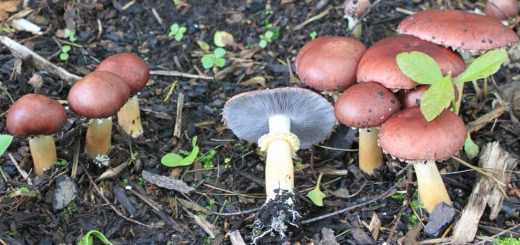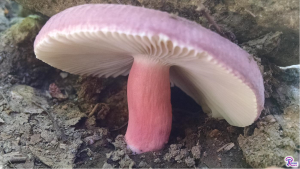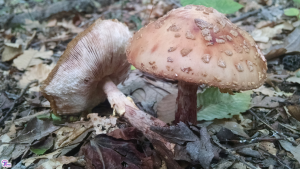#141: Pilobolus spp., the Hat Throwers
Fungi in the genus Pilobolus grow on the dung (they are “coprophilous”) of herbivores and are well-known for their unique spore dispersal mechanism. Using highly specialized spore-bearing hyphae, the fungus can launch globs of spores up to 3m (10ft) away! Its genus name literally means “Hat Thrower,” which is also used as a common name. Another common name is “Shotgun Fungus,” but that can also be applied to Sphaerobolus spp. (FFF#122), so I recommend against using that name.
The distinctive feature of Pilobolus species is their sporangia. Sporangia are structures produced by the zygomycetes (phylum Zygomycota has been disbanded but not completely replaced) that produce and disperse asexual spores. Most of the time, sporangia are fairly simple: a long hypha holds up a spore-filled sac that ruptures to disperse the spores into the air. Pilobolus species use a modified version of this: a long hypha ends with an enormous, swollen, liquid-filled vesicle that is topped with a dense, disc-shaped sac of spores. If you took an empty wrapping paper tube, stuck a lightbulb on the end, and glued an Oreo to the top of the lightbulb, you would have roughly the same shape. Although Pilobolus species produce relatively large sporangia, the structures rarely grow taller than 1cm (0.4in).
The most important part in this setup is the vesicle. Initially, the vesicle is packed full of sugar. Sugar readily absorbs water, which helps the fungus pump water into the vesicle. So much water is packed into that tiny space that the pressure inside the vesicle increases to about 5x atmospheric pressure. When the spores mature, the cell wall between the spore sac and vesicle breaks down and eventually ruptures. The sticky contents of the vesicle then explode out the top, carrying the spores with them. A video of this process can be found here: https://www.youtube.com/watch?v=T8OAmcUnm4g (from BBC Earth Unplugged). This widely-cited video concludes that Pilobolus spores are accelerated at 20,000 times the acceleration due to gravity on Earth (for comparison, the rifle and shotgun used in the video managed a mere 9,300G). Pilobolus spp. might not be very fast (its max speed is about 10.8 m/s or 35 ft/s), but they can certainly achieve one of the highest accelerations of all living things.
The vesicle is important for one other reason: it acts as a lens to focus light onto the area at the base of the vesicle. Photoreceptive pigments at the vesicle’s base ensure that the fungus is always pointed at the light. Here’s how it works. The vesicle and its contents are clear, allowing light to pass through. However, the spore sac is black. When the sporangium is pointed directly at the light, the spore sac will shade the base of the vesicle. If the sporangium is not aligned properly, the sun will illuminate part of the vesicle’s base. In this case, the fungus will be stimulated to turn towards the light. I’m not sure exactly how this happens, but if I had to guess, the illuminated pigments probably inhibit growth on their side. This would make the shaded side grow faster and cause the sporangium to turn towards the sun.
Why is photoreception important to Pilobolus? There are two reasons. First, it allows the fungus to shoot its spores through gaps in the leaf cover. This system, although simple, is fairly accurate and can hit dime-sized targets. Second, Pilobolus shoots off its spores in the early morning when the sun is low in the sky, thus ensuring the spores are flung away from where the fungus is growing.
So how does this complicated machinery benefit the fungus? It all comes down to poop. Pilobolus species decompose herbivore dung. Specifically, the dung of herbivores that feed on grass. Pilobolus begins its life cycle as a spore waiting on grass to be eaten by an herbivore. Once eaten, the spore passes through the digestive system unharmed and is eventually pooped out. Once in dung, it germinates and quickly colonizes the nutrient-rich environment. After less than a week, Pilobolus is ready to produce spores. The big problem for the fungus is how to make sure an animal eats its spores. Herbivores avoid eating near their own poop, so Pilobolus must get its spores off of the dung. Its unique sporangia allow the spores to be dispersed far away from the offending dung.
There is one group of organisms that specifically take advantage of Pilobolus’s spore dispersal strategy: lungworms in the genus Dictyocaulus. These lungworms primarily cause respiratory infections in grazing animals. The lungworm life cycle starts out in the animal’s lungs. There, a lungworm egg hatches, causes bronchitis and waits to be coughed up in mucous. Once coughed up, it is swallowed and eventually pooped out. The lungworm larvae then transform into an infective stage and must be eaten by an herbivore. In order to be eaten, the worm must get off of the dung. The most effective way to do this is to hitch a ride on Pilobolus spores, which are also trying to get away from the dung! After being eaten, the lungworm gets into the animal’s blood stream and makes its way to the lungs. There, the worms mature, mate, and make more lungworms. Using Pilobolus as a dispersal mechanism is so effective for the lungworms that one study found that cows in pastures with Pilobolus had seven times as many lungworms as those in pastures without the fungus. The tiny worms do not directly harm or benefit the fungus, making the Pilobolus/Dictyocaulus relationship one of the best examples I have seen of commensalism.
Would you ever think of eating this fungus? Probably not. But the folks at California Fungi did. To no one’s surprise, the edibility is listed as, “Unknown; inconsequential.” The authors also note that the fungus’s odor is “not distinctive” (probably because of the overpowering aroma of the dung on which the fungus is growing) and its taste is “not determined.”
One further interesting thing about Pilobolus is that there is a dance company named after it! I suppose that’s fitting, since Pilobolus is one of the most acrobatic fungi.
See Further:
https://www.youtube.com/watch?v=T8OAmcUnm4g (video from above)
http://www.mykoweb.com/CAF/species/Pilobolus_roridus.html
http://www.extension.umn.edu/garden/yard-garden/diseases/birds-nest-fungi/
https://blog.mycology.cornell.edu/2006/12/14/pilobolus-and-the-lungworm/

![#143: Boletinellus merulioides, the Ash Tree Bolete [Archived]](https://www.fungusfactfriday.com/wp-content/themes/hueman/assets/front/img/thumb-medium-empty.png)






![#011: Characteristics of Kingdom Fungi [Archived]](https://www.fungusfactfriday.com/wp-content/themes/hueman/assets/front/img/thumb-small-empty.png)


